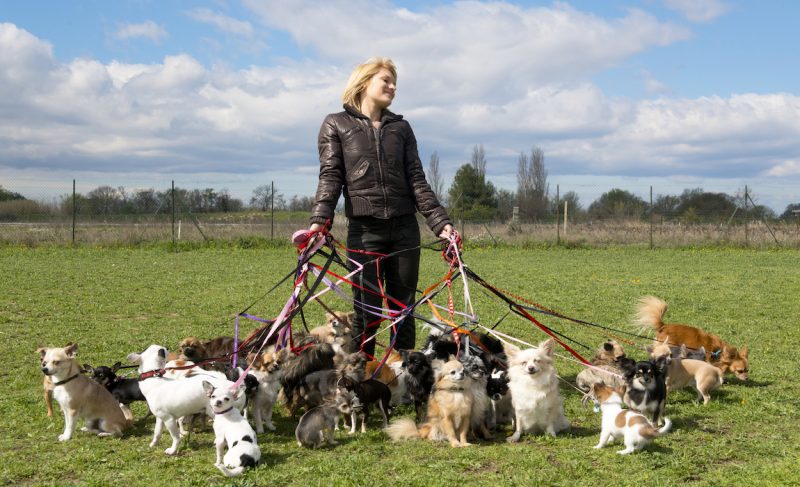I wanted a dog that loved fetch more than I do. That’s what I told everyone.
And I love playing fetch. I grew up with labs and was pretty proud of my tennis-ball-throwing skills.
Enter Barley. Barley is a three year old border collie, and he likes fetch. A lot. His pupils dilate almost instantly when I pick up a tennis ball. We can’t leave toys out or he’ll constantly ram them into our legs, begging for fetch.
He digs at cabinets storing fetch objects. He will bring people limes, stickers, and feathers when we hide the toys.
He doesn’t just like fetch – he is obsessed.

I got what I was looking for, but when I first got my new dog, he was so focused on fetch that he turned down steak in exchange for a tennis ball. I’ve owned him for three months and I’ve never seen him actually play with another dog.
How could I help him become a slightly more normal member of the household?
Together, Barley and I have been working on easing up on his unconditional love of fetch. Today I’ll be covering some of the strategies and tips I’ve used to help Barley realize there is a whole world outside of the word “fetch” and how I’ve managed to retain my sanity.
When Fetch is a Problem
Fetch is a fantastic way to wear out your dog. That’s why it was one of my number one criteria when I was looking for a dog. I’m a runner and hiker, but some days it’s nice to just throw a frisbee for your dog.
It’s not nice to have a dog that’s so single-minded about something that he’d be clinically diagnosed as OCD if he were a human!
When I first adopted Barley, I couldn’t pet him. As soon as I looked at him or reached for him, he darted off to find something – anything – for me to throw. This bummed me out. I wanted to be able to pet my dog and do things other than fetch!

For the vast majority of dogs, fetch won’t turn into this obsessive fixation. Most will enjoy catching the occasional frisbee or ball and won’t flip out when you move on to another activity.
For others, they get hooked on the fixed action pattern and little bursts of happiness they receive every time they fetch a ball – and this is where fetch can become a problem.
Your dog might be a fetch maniac if…
- Your dog frequently refuses to engage in other activities because he’d rather play fetch.
- You have to lock up tennis balls to keep your dog from constantly bugging you to play fetch.
- You have to physically restrain your dog to keep him from playing fetch or chasing objects.
- Your dog plays fetch anywhere, anytime and has a hard time quitting even when tired or hot.
Fetch can even end up being dangerous if your dog is too obsessed! I’m fully confident that Barley would fetch until he drowned or overheated if I let him.
I have to keep a very close idea on Barley when playing fetch to ensure that he’s not overheating. As an owner, it’s my job to keep him safe, and having a fetch-obsessed dog sometimes means you have to work overtime.
If you have a fetch maniac, you’ll need to keep an eye on the temperature as well as his water consumption helps keep him safe. Familiarize yourself with warning signs of overheating in dogs – this is important no matter how much your dog loves fetch!
So how can you help your fetch maniac settle down and enjoy other things in life?
Trainer’s Tip: Create Fetch Rules to Teach Impulse Control
Luckily, there are a lot of ways to reduce your dog’s obsession with fetch. The key is to make some strict rules surrounding fetch and then build up your dog’s impulse control when toys are involved.
Stick to your guns – at least at first. Inconsistent rule making will just confuse your dog. If you occasionally break rules, your dog might just think he has to try harder in order to get what he wants.
The good news? As your dog learns impulse control with fetch, you can slowly start to ease up on many of these rules.
Hide the tennis balls. Keep keep all fetch toys under wraps unless it’s time to play fetch. Your dog will have to learn to entertain himself other ways, breaking the cycle of constant fetch. This will make it much easier to follow the next several steps.
Time your fetch sessions. Set a five-minute timer for rounds of fetch. Use a cue like “last one” before throwing the ball for the last time, and then use a cue like “all done” before tucking the ball into a bag and heading home. This will keep your dog safe from heat and help teach your dog how to calmly end the game. As your dog gets better at this, you can gradually increase the time that you play fetch.
No fetch inside. This rule is really, really important for your sanity – and your floors! Keeping tennis balls locked up will help immensely, but you probably still want to leave out some other toys. If your dog starts giving you squeaky toys or tug toys for fetch, just ignore him. Eventually, he will give up and go do something else.
Only fetch when human initiates. This rule is ultra-important for teaching your dog how to entertain himself in other ways. This might mean stepping over seemingly endless sticks while on walks. It’s ok if your dog carries the stick around, but if he drops it at your feet you have to ignore him.
Dealing With Your Dog’s Fetch Mania
Use Fetch as a Reward
The good thing about a fetch-loving pooch is that fetch can utilized as great reward during training time!
For example, reward your dog for letting you trim his nails by tossing his favorite Frisbee after each nail clip. This is more effective than treats for many fetch maniac dogs.
Teach Impulse Control By Rewarding Your Dog For Ignoring Fetch Objects
Also try rewarding your dog for ignoring favorite fetch toys. You can set your dog up to practice impulse control by walking him past a tennis ball while on leash. Reward him for not picking it up with really tasty training treats.

Alternatively, produce a different toy from your bag and reward him for ignoring one toy with another! This will help your dog learn to focus on you more.
Impulse control in general is important for fetch maniac dogs. Some common impulse control games include Nothing In Life Is Free and It’s Your Choice. Try these out with your fetch maniac as well!
Show Your Dog How to Stop and Smell the Roses
It’s a good idea to learn new ways to tire out your dog that doesn’t involve fetch.
The frantic sprinting of fetch isn’t really the healthiest way to wear out your dog anyway, so think about trying jogging, long walks, hiking, dog joring sports, swimming, and training games as ways to wear out your dog. Be sure to calmly ignore pleads for fetch along the way!
Barley still spends the first 20 minutes of most of our hikes placing sticks at my feet before he decides to give up and enjoy the hike. This lower-key energy release gives him time to sniff and leaves him in a much more all-around tired state when we’re done.

Teaching your dog other ways to have fun is important to a well-rounded dog. Fetch maniacs can learn impulse control around toys and can learn to have fun in new ways. They may love the game fetch, but it’s good for them to have diverse interests.
Keep your dog safe and happy by making fetch a reasonable love affair, not an all-out-obsession!
How did you know your dog was over-the-top for fetch? What did you do to help him learn some self-control around his favorite game?








Leave a Comment